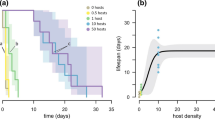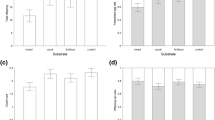Summary
Colony defense has been reported in a limited number of species of aphids. This paper examines which life-historical traits have promoted the evolution of colony defense using two kinds of deterministic simulation models. These models postulate that first-instar larvae can counterattack predators and that the duration of this instar stage is a variable, subject to selection. Prolonging the first-instar span increases the proportion of defenders in the colony, while it results in a delay in reproduction. By calculating the optimal first-instar span, the optimal defensive effort of a colony under various ecological conditions could be estimated. Simulations based on the general model, which regards the number of adults maturing in a period as performance, predicted that a lower birthrate leads to a longer first-instar span (larger investment in defense). This condition also allowed the evolution of dimorphism in the first-instar span, which may ultimately result in the appearance of soldiers. Where birthrate declines with time, the first-instar span was predicted to be prolonged in later stages. Colony duration had little influence on the optimal first-instar span if the season is long enough to repeat generations. The galling-aphid model that assumes a fixed number of generations predicted that a longer duration of colonies leads to a longer first-instar span, but that birthrate has little influence on the optimal first-instar span. A tendency in defense reported in pemphigid aphids was consistent with the prediction from the galling-aphid model.
Similar content being viewed by others
References
Akimoto, S., 1983. A revision of the genusEriosoma and its allied genera in Japan (Homoptera: Aphidoidea).Insec. Matsum. N. S. 27:37–106.
Akimoto, S., 1992. Shift in life-history strategy from reptroduction to defense with colony age in the galling aphidHemipodaphis persimilis producing defensive first-instar larvae.Res. Popul. Ecol. 34:359–372.
Aoki, S., 1977.Colophina clematis (Homoptera, Pemphigidae), an aphid species with “soldiers”.Kontyu 45:276–282.
Aoki, S., 1978. Two pemphigids with first instar larvae attacking predatory intruders (Homoptera, Aphidoidea).New Entomol 27:7–12.
Aoki, S., 1982. Soldiers and altruistic dispersal in aphids. In:The Biology of Social Insects (M. D. Breed, C. D. Michener and H. E. Evans, Eds.), Westview Press, Boulder, pp. 154–158.
Aoki, S., 1987. Evolution of sterile soldiers in aphids. In:Animal Societies: Theories and facts (Y. Ito, J. L. Brown and I. Kikkawa, Eds.), Japan Scientific Societies Press, Tokyo, pp. 53–65.
Aoki, S. and U. Kurosu, 1986. Soldiers of a European gall aphid,Pemphigus spyrothecae (Homoptera: Aphidoidea): Why do they molt.J. Ethol. 4:97–104.
Aoki, S. and U. Kurosu, 1988a. Secondary monoecy of a North American gall aphid,Pemphigus monophagus (Homoptera, Aphidoidea).Kontyu 56:394–401.
Aoki, S. and U. Kurosu, 1988b.Pemphigus “soldiers” and a defense of the generation-packing hypothesis: A response to Ito and Akimoto.J. Ethol. 6:65–67.
Cappuccino, N., 1987. Comparative population dynamics of two goldenrod aphids: Spatial patterns and temporal constancy.Ecology 68:1634–1646.
Cappuccino, N., 1988. Spatial patterns of goldenrod aphids and the response of enemies to patch density.Oecologia 76:607–610.
Caswell, H., 1982. Life history theory and the equilibrium status of populations.Am. Nat. 120:317–339.
Chambers, R. J. and T. H. L. Adams, 1986. Quantification of the impact of hoverflies (Diptera: Syrphidae) on cereal aphids in winter wheat: An analysis of field populations.J. Appl. Ecol. 23:895–904.
Coley, P. D., J. P. Bryant and F. S. Chapin, 1985. Resource availability and plant antiherbivore defense. Science230:895–899.
Dixon, A. F. G., 1985.Aphid Ecology. Blackie, Glasgow and London. 157 pp.
Foster, W. A., 1990. Experimental evidence for effective and altruistic colony defence against natural predators by soldiers of the gall-forming aphidPemphigus spyrothecae (Hemiptera: Pemphigidae).Behav. Ecol. Sociobiol. 27:421–430.
Hamilton, W. D., 1964. The genetical evolution of social behaviour. II.J. Theoret. Biol. 7:17–52.
Heie, O. E., 1980.The Aphidoidea (Hemiptera) of Fennoscandia and Denmark, I. Fauna Entomologica Scandinavica. Vol. 9. Scandinavian Science Press, Klampenborg, Denmark, 236 pp.
Itô, Y., 1989. The evolutionary biology of sterile soldiers in aphids.Trends in Ecology and Evolutionary Biology 4:69–73.
Kareiva, P., 1987. Habitat fragmentation and the stability of predator-prey interactions.Nature 326:388–390.
Kurosu, U. and S. Aoki, 1988. First-instar aphids produced late by the fundatrix ofCeratovacuna nekoashi (Homoptera) defend their closed gall outside.J. Ethol. 6:99–104.
Lampel, G., 1968.Die Biologie des Blattlaus-Generationswechsels. Gustav Fischer, Jena. 264 pp.
Moran, N. A., 1981. Intraspecific variability in herbivore performance and host quality: a field study ofUroleucon caligatum (Homoptera: Aphididae) and itsSolidago hosts (Asteraceae).Ecol. Entomol. 6:301–306.
Moran, N. A., 1992. The evolution of aphid life cycles.Annu. Rev. Entomol. 37:321–348.
Moran, N. A., 1993.Defenders in the North American aphid Pemphigus obesinymphae.Ins. Soc. 40:391–402.
Oster, G. F. and E. O. Wilson, 1980.Caste and Ecology in the Social Insects. Monographs in Population Biology 12. Princeton University Press, Princeton. 352 pp.
Sakata, K. and Y. Itô, 1991. Life history characteristics and behaviour of the bamboo aphid,Pseudoregma bambusicola (Hemiptera: Pemphigidae), having sterile soldiers.Ins. Soc. 38:317–326.
Stern, D. L., 1994. A phylogenetic analysis of soldier evolution in the aphid family Hormaphididae.Proc. R. Soc. Lond. B 256:203–209.
Stern, D. L. and W. A. Foster, 1995. The evolution of soldiers in aphids.Biol. Rev. in press.
Turchin, P. and P. Kareiva, 1989. Aggregation inAphis varians: An effective strategy for reducing predation risk.Ecology 70:1008–1016.
Author information
Authors and Affiliations
Rights and permissions
About this article
Cite this article
Akimoto, S. Ecological factors promoting the evolution of colony defense in aphids: computer simulations. Ins. Soc 43, 1–15 (1996). https://doi.org/10.1007/BF01253951
Received:
Revised:
Accepted:
Issue Date:
DOI: https://doi.org/10.1007/BF01253951




